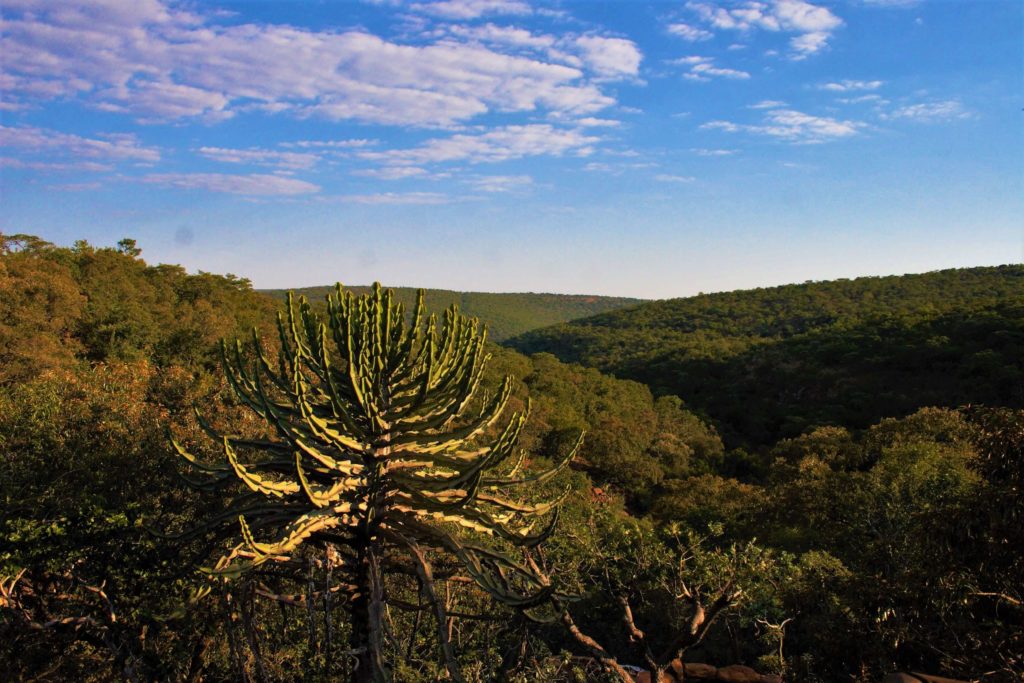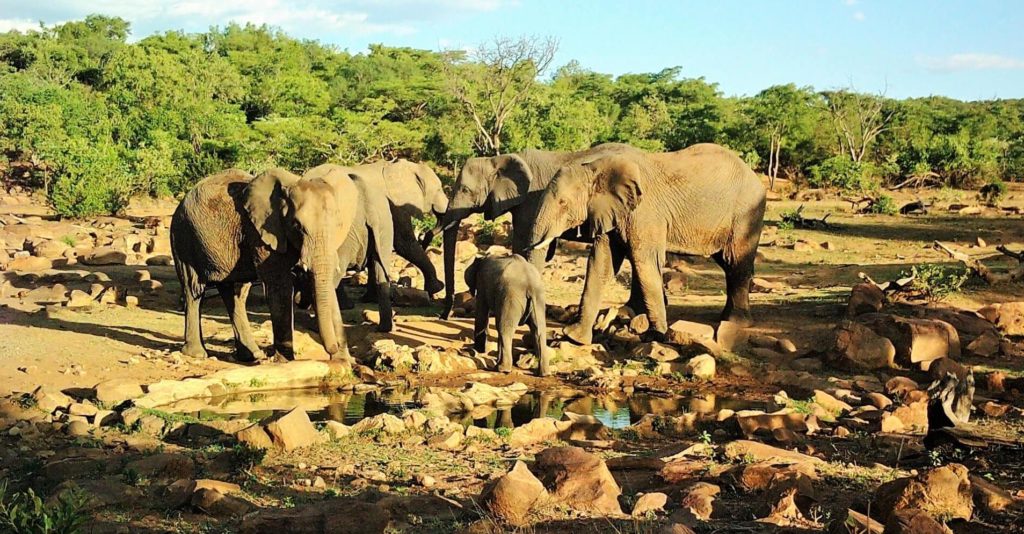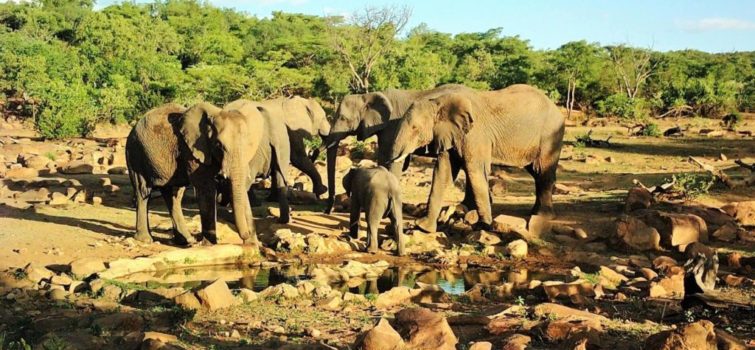Answering Some FAQs About Makweti
What Does Makweti Mean?
The name “Makweti” refers to the woody tree with the succulent branches and leaves that is characteristic in and around the camp and is better known as the Bushveld Candelabra, or Euphorbia cooperi. It is believed that the local or traditional name in this region for the Euphorbia cooperi tree is “Makweti”, a Sepedi-derived name. Sepedi is one of the 30 recognised dialects of the Northern Sotho language group, which is widely spoken in the northern and western areas of South Africa.
The camp is built in an area of the Welgevonden Game Reserve that is referred to as the “Makweti Gorge”. This gorge lies north of the camp and is the area we look onto from our breakfast deck down towards the Taaibos River Valley. This was covered in our blog on the Makweti Tree in March 2018.

What Type Of Vegetation Is Found On The Reserve?
Makweti Safari Lodge falls within the Welgevonden Game Reserve in the Waterberg Region of the Limpopo Province of South Africa. This game reserve forms part of the Waterberg Biosphere Reserve, which predominantly consists of vegetation known as savannah bushveld. The biosphere reserve is dominated by different bushveld types characteristic with mountainous savannah. The Welgevonden Game Reserve, which has vegetation dominated by sourveld bushveld and mixed bushveld falls within the core region of the 654,000ha Waterberg Biosphere Reserve. The biosphere reserve is home to 5,500 species of plants of which 43% are endemic to Southern Africa. It represents a considerable area of the savannah biome in Southern Africa, and is the only UNESCO-recognised Savannah Biosphere Reserve in the world.
The savannah biome is 1 of 7 recognised biomes of the world, and forms a large portion of Sub-Saharan Africa. Savannah is typically characterised as an African biome as the wide variety of mixed bushveld in savannah accommodates a multitude of herbivore species that form large grazing and browsing herds.
What Animals Come Close To The Camp?
We share the camp with a variety of local resident species of mammals, reptiles and birds. The resident Vervet Monkey troop are frequently seen and encountered. The Rock Hyrax or “Dassies” live among the rocks in which the camp is situated.
From time to time these resident species are visited by a variety of other mammal species found on the reserve. Sitting at the Indaba Lounge, overlooking the waterhole, one will witness the daily interaction between warthogs, impala, Burchells Zebra, wildebeest, kudu and chacma baboons. These regulars to our bushveld pub form the core of the groups of mammals seen at Makweti.
Elephant also frequent the camp looking for fresh water. Our waterhole supplies regular drinking water, but our swimming pools are also highly sought after. The pools found at chalets 2 and 4 are the number one choice for many elephant bulls.
There is a resident leopard in the mountains around Makweti, whose territory extends east of the camp and north into the Taaibos River Valley. She is shy and seldom seen, but we have caught her on camera and will often find her tracks on the road coming into camp. Jessica has been privileged to hear her on occasion on the hills behind the house.
Other night visitors who come into camp when all is quiet include brown hyena, honey badger, porcupine, civet and rhino.

How Many People Work At Makweti?
We have an excellent team who work diligently to ensure our guests have the most amazing experience possible. We are privileged to work with such committed people and are proud of their achievements on a daily basis. We have been featuring our staff in our People Of Makweti blogs, so keep an eye on who is next.
Our team comprises of lodge manager couple, 2 x guides, 1 x administrator, 1 x head chef, 1 x assistant chef, 2 x kitchen assistants, 4 x housekeepers and 2 x grounds and maintenance gents.
A total of 15 exceptional employees!
How Big Is The Reserve?
The Welgevonden Game Reserve measures 36,000 hectares in total. This equates to 88,920 acres or 360 km2. The reserve falls within the Waterberg Biosphere Reserve, which is 654,000 hectares large in its entirety.
Welgevonden Game Reserve falls within the core of the Waterberg Biosphere Reserve, which is 104,000 hectares large. The Waterberg Mountain range is 14,500 km2. By comparison, the world-renowned Kruger National Park is 19,485 km2.
How Old Is Makweti And Welgevonden Game Reserve?
In 1987, the concept of a game reserve was born. With the commitment of the private sector in South Africa and local farm land owners, the Welgevonden Game Reserve was proclaimed a conservation area in 1993. Pienkes du Plessis, the owner of the original farm “Welgevonden” had the initial vision of this ambitious conservation idea.
“I wanted to remove all traces of human activity from this landscape and reintroduce animals that had been lost to the area over time due to humans.”
In 1993, when the reserve was proclaimed, the internal fences between the farms were removed, conservation and land management activities were implemented, and a unique conservation area started to re-establish into its original state.
Shortly after the reserve’s official proclamation, development of the tourism model for the reserve was established, and in 1994 Makweti Safari Lodge was built, being one of the first lodges developed on the reserve.
Makweti Safari Lodge has remained a key player since, contributing to conservation initiatives and the promotion of the reserve and area as a whole for its significant ecological value as well as socio-economic significance.
Have All The Animals Always Been On The Reserve?
Yes and no. Of the 50 mammal species found on Welgevonden Game Reserve, all of them are indigenous and naturally occurring in this region.
In the early 1800’s, many species were hunted mercilessly with pioneers moving through this region. By the early 1900’s, many species were extinct from the area. On re-establishing the area to conservation status, key species were re-introduced into their natural environment. These included elephant, lion, white rhino and many general game species. Species such as kudu, klipspringer, impala, brown hyena and leopard would have occurred here naturally during the previous farming era, although in low numbers. Being protected under the conservation practices of the reserve, their numbers have grown considerably.
Although historically, many species would have been found here seasonally, moving into more fertile low-lying areas around the Waterberg range in the drier Winter months, they are now found all year round on the reserve where they are protected.
Spotted hyena were never re-introduced into the reserve as part of the Reserves Predator Management Plan, however, nomadic individuals from surrounding areas in the Limpopo, have re-established a small population within the reserve, regardless. This is exciting, as it shows that the conservation practices are allowing mammals, birds, reptiles and insects to move back into previously occupied areas on their own.
In November 2018, black rhino were re-introduced into the reserve, the first black rhino to walk in these hills for over a hundred years.
Why Does The Soil Differ In Colours In Some Areas?
The soils on the reserve are mostly based from sedimentary sand-stone rock, and as a result are relatively infertile, unable to hold the nutrients usually found in more clay or loamy soils. The Waterberg Massif has an abundance of iron and magnesium within it, which lends its colour to the resulting soils on the reserve. When exposed to water and oxygen, the iron in the rock and soils begins its oxidising process, resulting in the beautiful rich orange and red hues. Similarly, magnesium in its oxidising process results in the purple colours found in some areas.
How Many Key Species Are On The Reserve?
A game census is conducted most years around September, with a primary goal of establishing trends in animal populations, rather than to give a definite number of the species on the reserve. The numbers of each animal indicate changes in the ecological process within a seasonal change. For example: it indicates the success of animals birthing each year.
What’s in a number? Knowing the actual number of the species is of little ecological significance but following the trends year on year provides interesting insights into animal population dynamics, which are influenced by disease, drought, floods, rainfall and predator activity.
The rhino population is monitored closely and although we have a healthy population, figures are held secret to ensure their survival. The current rhino poaching situation in Africa is more than concerning and significant measures are always being taken to ensure these species are well protected.
What Is The Best Time Of Year To Visit Makweti?
The answer is simple – any time! Although the seasonal changes are noticeable, there is no single best time of year to travel to Makweti. Finding game in all seasons is a challenge we relish, and this makes it so much more exciting than having anything guaranteed.
Spring and Summer bring on the best in terms of the vegetation biodiversity, with plants flowering and fruiting and the reserve in vibrant, green splendour. Summer is a birder’s paradise with many migrant species returning to breed or simply overwinter in our warm climates as there’s an abundance of food available.
Winter brings everything we love about it: log fires, warm blankets, hot water bottles and the hearty fare that our Winter menus offer. The long Winter morning light provides great photographic opportunities and the wildlife look forward to the warm midday and early after sun as much as we do.
So, when is the best time to be Makweti? All the time.
References:
- Words and photographs: Neil Davison
- Personal observations by the author on Welgevonden Game Reserve
- All the colourful guests who have passed through our doors
- http://www.unesco.org/new/en/natural-sciences/environment/ecological-sciences/biosphere-reserves/africa/south-africa/waterberg/

